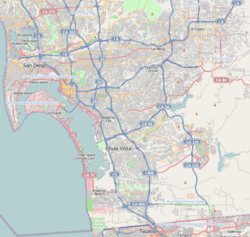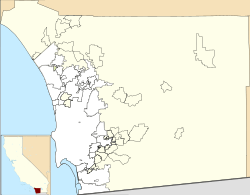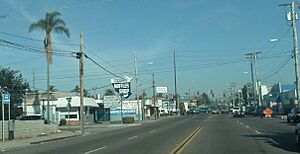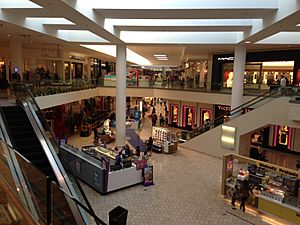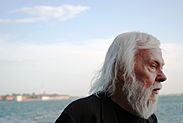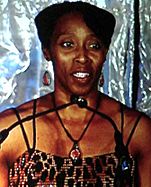National City, California facts for kids
Quick facts for kids
National City, California
|
|||
|---|---|---|---|
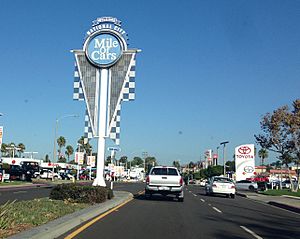
Welcome sign in 2012
|
|||
|
|||
| Motto(s):
"In the Center of It All"
|
|||
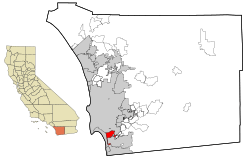
Location within San Diego County
|
|||
| Country | |||
| State | |||
| County | |||
| Founded | July 7, 1868 | ||
| Incorporated | September 17, 1887 | ||
| Government | |||
| • Type | Council–manager | ||
| Area | |||
| • Total | 9.12 sq mi (23.61 km2) | ||
| • Land | 7.29 sq mi (18.89 km2) | ||
| • Water | 1.82 sq mi (4.73 km2) 20.17% | ||
| Elevation | 66 ft (20 m) | ||
| Population
(2020)
|
|||
| • Total | 56,173 | ||
| • Density | 6,159/sq mi (2,379.2/km2) | ||
| Time zone | UTC-8 (Pacific) | ||
| • Summer (DST) | UTC-7 (PDT) | ||
| ZIP Code |
91950
|
||
| Area code | 619 | ||
| FIPS code | 06-50398 | ||
| GNIS feature IDs | 1661090, 2411216 | ||
National City is a city in the South Bay area of southwestern San Diego County, California. It is located near San Diego. In 2020, about 56,173 people lived there. National City is the second-oldest city in San Diego County. It became an official city in 1887.
Contents
History of National City
| Historical affiliations | Spanish Empire 1769–1821 | First Mexican Empire 1821–1823 | United Mexican States 1823–1848 | United States 1848–present |
|---|
People have lived in the area now known as National City for a very long time. Some evidence suggests humans were here as far back as 130,000 years ago. Before Spanish explorers arrived, the Kumeyaay tribe lived here. They had a village near Chollas Creek, north of where National City is today.
The Spanish called this land El Rancho del Rey, meaning "the Ranch of the King." Spanish soldiers used it to graze their horses. After Mexico became independent from Spain in 1810, the Mexican government renamed it Rancho de la Nación, or "Ranch of the Nation." In 1845, Governor Pío Pico gave this land to his brother-in-law, John (Don Juan) Forster. Later, when the United States took over, President Andrew Johnson called it "The National Ranch."
In 1868, three brothers named Frank, Warren, and Levi Kimball bought the entire ranch. They were contractors from San Francisco. This is how the city of National City began, keeping the "National" name.
How National City Grew
Frank Kimball brought many new things to the area. He built his own house with a bathtub and hot running water. This was the first modern house in the whole county! The Kimball brothers also built the first roads and railroad in National City. This helped people travel and move goods.
They also started the area's first post office and a wharf for ships. The Kimballs even planted trees from Europe and Asia. You can still see some of these trees around the city today. Because of their hard work, National City officially became a city on September 17, 1887.
In the mid-1900s, a street called National Avenue was known as the "Mile of Bars." Later, the city wanted to change this image. They encouraged car dealerships to open there. Now, this area is famous as the "Mile of Cars."
National City has many beautiful Victorian-style homes. Many of these were built in the late 1800s. A great example is Brick Row. Frank Kimball built these homes in 1887 for railroad workers. Today, these historic buildings are part of Heritage Square. This area helps people learn about National City's past.
Supporting the Community
National City is home to many immigrants and refugees. In 2017, the National City Council voted to adopt a "Compassionate City resolution." This resolution shows the city's support for immigrants. It means the city wants to help all its residents feel welcome and safe.
Geography and Location
National City covers about 9.1 square miles (23.6 square kilometers). Most of this is land, with some water areas. The city is next to San Diego to the north. To the south, it borders Chula Vista across the Sweetwater River. San Diego Bay is to the west.
The city is easy to reach by major highways like Interstate 5 and Interstate 805. It also has access to the San Diego Trolley's Blue Line. The closest airport for travel is San Diego International Airport.
In 2012, National City was named the most walkable city in San Diego County. This means it's easy to get around on foot. It has a high "walk score" compared to other cities.
Neighborhoods and Communities
National City has different areas that feel like their own communities. For example, the Old Town community is between McKinley Avenue and National City Boulevard.
Even though Lincoln Acres is not officially part of National City, it is completely surrounded by the city. Both areas share the same postal code.
The city also has a Neighborhood Council Program. This program helps people in different neighborhoods talk to city leaders. It helps residents work together to improve their areas. They can discuss concerns and help with clean-up events. They also enjoy family events like "Movies in the Park."
Climate and Weather
| Weather chart for National City, California | |||||||||||||||||||||||||||||||||||||||||||||||
|---|---|---|---|---|---|---|---|---|---|---|---|---|---|---|---|---|---|---|---|---|---|---|---|---|---|---|---|---|---|---|---|---|---|---|---|---|---|---|---|---|---|---|---|---|---|---|---|
| J | F | M | A | M | J | J | A | S | O | N | D | ||||||||||||||||||||||||||||||||||||
|
1.9
69
46
|
2.4
68
48
|
1.7
68
50
|
0.7
70
53
|
0.1
70
58
|
0.1
72
61
|
0
76
65
|
0
78
66
|
0.1
78
63
|
0.5
76
58
|
0.9
72
50
|
1.4
67
42
|
||||||||||||||||||||||||||||||||||||
| temperatures in °F precipitation totals in inches |
|||||||||||||||||||||||||||||||||||||||||||||||
|
Metric conversion
|
|||||||||||||||||||||||||||||||||||||||||||||||
National City has a mild climate all year. Summers are warm and dry. Winters are mild with most rain falling between December and March. The average temperature is often above 72°F (22°C).
Sometimes, especially in May and June, a thick layer of clouds called the "marine layer" keeps the air cool near the coast. The highest temperature ever recorded was 108°F (42°C) in September 1988. The lowest was 15°F (-9°C) in April 2003.
Nature and Wildlife
Like much of Southern California, National City was once covered by chaparral plants. These are tough shrubs that can live in dry conditions.
National City is home to parts of the San Diego National Wildlife Refuge. It also includes the northern part of the Sweetwater Marsh National Wildlife Refuge. The Sweetwater River flows through the city and into San Diego Bay. The western part of National City is flat, which made it good for grazing horses in the past. The eastern areas have canyons and hills with existing wildlife.
People and Population
| Historical population | |||
|---|---|---|---|
| Census | Pop. | %± | |
| 1880 | 248 | — | |
| 1890 | 1,353 | 445.6% | |
| 1900 | 1,086 | −19.7% | |
| 1910 | 1,733 | 59.6% | |
| 1920 | 3,116 | 79.8% | |
| 1930 | 7,301 | 134.3% | |
| 1940 | 10,344 | 41.7% | |
| 1950 | 21,199 | 104.9% | |
| 1960 | 32,771 | 54.6% | |
| 1970 | 43,184 | 31.8% | |
| 1980 | 48,772 | 12.9% | |
| 1990 | 54,249 | 11.2% | |
| 2000 | 54,260 | 0.0% | |
| 2010 | 58,582 | 8.0% | |
| 2020 | 56,173 | −4.1% | |
| U.S. Decennial Census | |||
In 2020, National City had a population of 56,173 people. The city is very diverse. About 66% of residents are of Hispanic or Latino background. Other groups include Asian, African American, and White residents.
The average household income in 2020 was about $51,735. About 15.2% of people in National City live below the poverty level.
Economy and Jobs
National City has many different businesses and industries. You can find stores, restaurants, and manufacturing companies here. The city works to make sure businesses follow rules, like getting permits and licenses. This helps keep the city organized and safe for everyone.
Tourism and Attractions
Tourism is important in San Diego County. In 2012, National City created a Tourism Marketing District. This group helps promote the city to visitors. Their goal is to make National City a great place for tourists, meetings, and events. This helps local hotels and businesses.
Major Employers
Many people work in National City. Here are some of the top employers in the city:
| # | Employer | # of employees |
|---|---|---|
| 1 | Paradise Valley Hospital | 1,138 |
| 2 | National Elementary School District | 462 |
| 3 | Sweetwater Union High School District | 400 |
| 4 | Wal-Mart | 400 |
| 5 | NMS Management | 300 |
| 6 | Dixieline Lumber | 285 |
| 7 | City of National City | 275 |
| 8 | Ball Automotive Group | 250 |
| 9 | Macy's | 250 |
| 10 | Motivational Systems, Inc. | 245 |
| 11 | Mossy Nissan | 298 |
Arts and Culture in National City
Places to Visit
- The National City Mile of Cars: This is one of the first "auto malls" in the world. It's a huge area with many car dealerships.
- National City Port Area: This 3-mile (5 km) port area along San Diego Bay is part of Naval Base San Diego. It is the largest U.S. Naval base on the west coast.
- National City Depot: Built in 1882, this train station was the first Pacific Coast stop for the Santa Fe Railway. It was very important for connecting California to the rest of the country by train. It is now a California Historical Landmark. You can find it at 900 West 23rd St.
- Westfield Plaza Bonita: This is a large indoor shopping mall in National City. Many people from the South Bay area come here to shop.
- Paradise Valley Hospital: This hospital was founded in 1902. It is a 301-bed facility that provides acute care.
- Cafe La Maze: Opened in 1941, this is one of National City's oldest and most famous restaurants.
- Olivewood Gardens: This is an old Victorian-style house where John T. Walton used to live.
- Brick Row on Heritage Square: These 10 unique row houses were built in 1887 for railroad executives. They are designed in a style similar to homes in eastern cities. Each unit is privately owned, but their historic look is protected. They are listed on the National Register of Historic Places.
Education and Learning
National City has many schools for students of all ages.
Elementary Schools
National City's 10 public elementary schools are part of the National School District.
- Central
- El Toyon
- Ira Harbison: This school has won awards like the Blue Ribbon School (2006) and California Distinguished School (2004).
- John Otis
- Kimball: Also a California Distinguished School (2004).
- Las Palmas
- Lincoln Acres
- Olivewood
- Palmer Way
- Rancho de la Nación (formerly New Horizons School)
Charter Schools
- Integrity Charter School: A K–8 school.
- The Charter School of San Diego (located in Plaza Bonita Mall).
Middle and High Schools
National City's public middle and high schools are part of the Sweetwater Union High School District.
- Middle school: National City Middle School
- Junior High school: Granger Junior High School: This school has been recognized as a California School to Watch multiple times (2010, 2013, 2016, 2019, 2020).
- High school: Sweetwater High School
Private Schools
- San Diego Academy: A Seventh-day Adventist school for K–12 students.
- Faithful Ambassadors Bible Baptist Academy: For PreK–12 students.
- Gospel Light Christian School: For PreK–12 students.
Libraries and History Resources
The National City Public Library is a modern, large facility. It opened in 2005 and has over 160,000 books. It also has one of the biggest computer centers in California's public library system.
The first public library in National City was opened by Frank Kimball in his own home in 1884. Over the years, it moved to different locations. The library also has the Kile Morgan Local History Room. This room holds old documents, maps, and photos about the founding families of National City. It's a great place to learn about the city's past.
Notable People from National City
Many famous people have connections to National City, including:
- John Baldessari: A well-known conceptual artist, born in National City.
- Joe Corona: A soccer player for Club Tijuana and the United States team. He went to Sweetwater High School.
- Gail Devers: An amazing athlete who won three Olympic gold medals.
- Donnie Edwards: A former National Football League player for the San Diego Chargers.
- Benji Gil: A former Major League Baseball player.
- Rosie Hamlin: A singer famous for the 1960s song "Angel Baby."
- Joe Orrell: A former Major League Baseball pitcher, born in National City.
- Skid Roper: A musician.
- Dan Saleaumua: A former player in the National Football League, born in National City.
- Juan Vargas: A U.S. Representative, born in National City.
- Tom Waits: A famous singer/songwriter and musician.
- Lukas Walton: A billionaire heir and grandson of Sam Walton, who founded Walmart.
Sister Cities
National City has two sister cities, which are cities that partner with each other to promote cultural ties:
 Tecate, Mexico
Tecate, Mexico Olongapo, Philippines
Olongapo, Philippines
See also
 In Spanish: National City para niños
In Spanish: National City para niños




